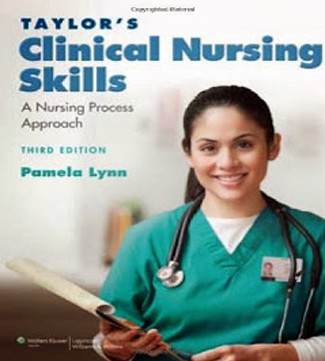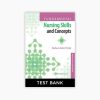Taylor’s Clinical Skills A Nursing Process Approach 3rd Edition Lynn Test Bank
$35.00 Original price was: $35.00.$26.50Current price is: $26.50.
Taylor’s Clinical Skills A Nursing Process Approach 3rd Edition Lynn Test Bank
This is completed downloadable of Taylor’s Clinical Skills A Nursing Process Approach 3rd Edition Lynn Test Bank

Product Details:
- ISBN-10 : 078179384X
- ISBN-13 : 978-0781793841
- Author: Pamela Lynn
This heavily illustrated and clearly written text details over 185 basic and advanced skills, and is specifically designed to correspond with Taylor’sFundamentals of Nursing, Seventh Edition for a consistent teaching/learning experience. The procedures and skills are outlined in a step-by-step manner that follows the nursing process format (with rationales), and includes documentation guidelines and samples; a new Evidence-based Practice Feature; and Unexpected Situations, which explain how to respond to unanticipated outcomesa feature unique to this text.
Table of Content:
1. A nurse is teaching parents of preschoolers appropriate safety measures for this age group. Which of the following might be a focus of the teaching plan?
A) Childproofing the house
B) Smoking cessation
C) Fire safety
D) Gun safety
2. Which of the following populations would benefit from fall prevention strategies based on their developmental stage? Select all that apply.
A) Newborns
B) Toddlers
C) School-age children
D) Adolescents
E) Adults
F) Older Adults
3. A nurse caring for a confused patient who is not allowed to get out of bed asks the physician for an order for restraints. Which of the following are guidelines for the use of restraints on patients? Select all that apply.
A) Restraints may be used to prevent a patient from falling when the facility is short-staffed.
B) The patient’s family must be involved in the decision and plan of care.
C) Alternatives to restraints and less restrictive interventions must have been implemented and failed.
D) The benefit gained from using a restraint must outweigh the known risks for that patient.
E) A physician or licensed independent practitioner must reevaluate and assess the patient every 48 hours.
F) The patient’s vital signs must be assessed and the medical patient must be visually observed every 4 hours.
4. A nurse enters a patient’s room and finds that the patient has fallen on her way to the bathroom. Which of the following is a prudent nursing intervention for this patient?
A) Briefly leave the patient in order to call the primary physician to assess the patient’s condition.
B) Order x-rays or CT scans for the patient, as needed.
C) Document the incident, assessment, and interventions in the patient’s medical record.
D) Do not file an event report unless the patient is seriously injured in the fall.
5. A patient with impaired mobility related to a recent knee replacement is being discharged to her home with a follow-up from a home healthcare nurse. What patient teaching regarding safety should the nurse share with this patient to prevent falls?
A) Abstain from exercising until the knee is completely healed.
B) Keep home temperature at a moderate level to prevent dizziness.
C) Wear socks around the house to avoid catching a heel in a rug.
D) Stand up quickly from a sitting or lying position to allow blood to move to the head.
6. Mr. Geno is an 87-year-old patient in a nursing home who keeps trying to get out of bed to use the bathroom, despite having a catheter in place. Which of the following interventions would help keep this patient safe and could be used as an alternative to restraints?
A) Investigate the possibility of discontinuing his catheter.
B) Remove personal items, such as plants, books, and radios, from the environment.
C) Ask the family to limit visits to the morning hours when the patient is calmest.
D) Reduce daily exercise to promote rest and relaxation.
7. A doctor orders restraints for an elderly patient who is disoriented from the pain medication she is taking. Which of the following is an appropriate guideline for applying these restraints?
A) Chemical restraints should be tried before using physical restraints.
B) The restraints can be ordered by the nursing supervisor in emergency situations.
C) The patient’s vital signs must be assessed every hour.
D) Adults must be reassessed within 4 hours; children (aged, 9 to 17 years) within 2 hours; and children less than age 9 years within 1 hour.
8. Which of the following statements accurately describes a letter represented in the R-E-S-T-R-A-I-N-T acronym (Dibartolo, 1998)?
A) Respond to the past history of the patient (including past falls) to determine the need for restraints.
B) Alert the physician and the patient’s family if restraints are ordered by the nursing team.
C) Individualize the use of restraints and choose the most restrictive device to provide the best protection for the patient.
D) Time-limit the use of restraints; restraints should be used no longer than 24 hours on nonpsychiatric patients.
9. A physician orders restraints for a confused patient who is at risk for injury by pulling out tubes necessary to sustain her life. Which of the following statements describes an accurate action to take when applying these restraints?
A) Apply restraints to the hands or wrists, never to the ankles.
B) Ensure that two fingers can be inserted between the restraint and the patient’s extremity.
C) Use a quick-release knot to tie the restraint to the side rail.
D) Remove the restraint at least every 4 hours, or according to agency policy.
10. Which of the following statements is an accurate guideline for applying a waist restraint?
A) Place the patient in a prone position to apply the restraint.
B) Remove the clothing on the upper body and reapply over the restraint.
C) Insert the fist between restraint and patient to ensure that breathing is not constricted.
D) Assess the patient at least every 2 hours or according to facility policy, as required.
11. A nurse caring for a 6-year-old patient notices that he is attempting to pull on a surgical incision. What would be the best type of restraint to prevent him from doing this?
A) Elbow restraint
B) Vest restraint
C) Extremity restraint
D) Mummy restraint
12. Which of the following is a recommended guideline for applying an elbow restraint?
A) Choose the correct size of the device that allows for the least amount of mobility.
B) Spread elbow restraint out flat, and place middle of elbow restraint behind patient’s elbow.
C) Make sure the restraint extends below the wrist and does not put pressure on the axilla.
D) Wrap restraint snugly around the patient’s arm but make sure that a fist can easily fit under restraint.
13. What would be the best restraint to use on an infant during care for a head wound?
A) Elbow restraint
B) Waist restraint
C) Extremity restraint
D) Mummy restraint
14. A nurse is placing an infant in a mummy restraint in order to perform eye care. Which of the following is a recommended guideline for application of a mummy restraint?
A) Place the child on the blanket, with edge of blanket at or above neck level.
B) Position the child’s left arm alongside the body and pull the right side of the blanket over the shoulder and chest.
C) Leave the lower part of blanket open and pull the sides of the blanket over the child’s body.
D) Secure the blanket under the child’s body on each side by tucking it in instead of using safety pins.
15. Which of the following patients would be the most likely candidate for the use of a waist restraint?
A) A patient with Alzheimer’s disease who has a history of walking out of his long-term care facility
B) A patient who may use her hands to pull out a catheter
C) A teenager who is in an agitated state due to taking illegal drugs
D) A confused elderly patient in a hospital who tries to get out of bed following hip surgery
Answer Key
1. C
2. A, B, C, F
3. B, C, D
4. C
5. B
6. A
7. D
8. D
9. B
10. C
11. A
12. B
13. D
14. A
15. D
People Also Search:
taylor’s clinical skills a nursing process approach
taylor’s clinical skills a nursing process approach 3rd edition lynn
taylor’s clinical skills a nursing process approach 3rd edition lynn download scribd
taylor’s clinical skills a nursing process approach 3rd edition lynn test bank download pdf











